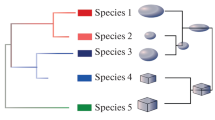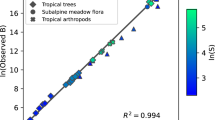Abstract
Hierarchy of systems organization is used as a framework in advancing methodological guidelines for posing correct questions related to ecological diversity.
Diversity if defined in general terms as a property of a set of elements dependent on and determines: by the epistemological perspective. Ontological diversity, because it is indefinite, is regarded as unmeasurable.
Ecological diversity — be it species, spatial, reproductive or trophic, is a particular case of diversity of matter and must be precisely defined on the studied level of system organization.
Diversity measurements combining more than one level of organization are information-void, for data become irretrievable as a result of such a treatment.
Hypotheses explaining diversity sources are briefly surveyed. An integrated model interrelating them is constructed as a result of some basic views on the structure of matter coupled with the empirical knowledge of involved factors. The model reflects hierarchies of systems, their dynamics, and the complexities of factors affecting diversity. The model's properties suggest that it is conceptually related to an imaginary model of organization of ecological systems. Parameters recognized as invariant components of this complexity are: habitat differentiation, ecological specialization of species, ambiental changes, and integration of this system.
Finally, it is shown that the peculiar shape of the species abundances curve is a necessary consequence of stratification of the system structure, which is an intrinsic attribute of hierarchical organization.
Similar content being viewed by others
References
Allen, T.F.H., and Starr, T.B. (1982). Hierarchy.- Chicago: The University of Chicago Press.
Caswell, H. (1976). Community structure: a neutral model analysis. Ecol Monogr 46: 327–354.
Colwell, R.K. (1979). Toward a unified approach to the study of species diversity. In J.F. Grassle, G.P. Patil, W.K. Smith and C. Taillie, eds., Ecological diversity in theory and practice, 75–91. Fairland, MD: Int Co-operative Publ House.
Connell, J.H., and Orias, E. (1964). The ecological regulation of species diversity.- Amer Nat 98: 399–414.
Conrad, M. (1979). Hierarchical adaptability theory and its cross-correlation with dynamical ecological models. In Halfon, ed., Theoretical systems ecology, 131–150. New York: Academic Press.
Dennis, B., Patil, G.P., Rossi, O., Stehman, S., and Taillie, C. (1979). A bibliography of literature on ecological diversity and related methodology. In J.F. Grassle, G.P. Patil, W.K. Smith and C. Taillie, eds., Ecological diversity in theory and practice, 319–353. Fairland, MD: Int Co-operative Publ House.
Dritschilo, W., and Erwin, T.L. (1982). Responses in abundance and diversity of cornfield carabid communities to differences in farm practices. Ecology 63: 900–904.
Grant, P.R. (1972). Convergent and divergent character displacement. Biol J Linn Soc 4: 39–68.
Halfon, E. (1979). Theoretical systems ecology. Advances and case studies.- New York: Academic Press.
Hendrickson, J.A. (1979). The biological motivation for abundance models. In J.K. Ord, G.P. Patil and C. Taillie, eds., Statistical distributions in ecological work, 263–274. Fairland, MD: Int Co-operative Publ House.
Hengeveld, R. (1979). On the use of abundance and species-abundance curves. In J.K. Ord, G.P. Patil and C. Taillie, eds., Statistical distributions in ecological work, 275–288. Fairland, MD: Int Co-operative Publ House.
Hilbron, R., and Stearns, S.C. (1982). On inference in ecology and evolutionary biology: the problem of multiple causes.- Acta Biotheor 31: 145–164.
Keddy, P.A. (1976). Lakes as islands: the distributional ecology of two aquatic plants, Lemna minor L. and L. trisulca L.- Ecology 57: 353–358.
Kolasa, J. (1979). Ecological and faunistical characteristics of Turbellaria in the eutrophic Lake Zbechy.- Acta Hydrobiol 21: 435–459.
Lipiec, J. (1973). W poszukiwaniu stuktury przedmiotu (In search of the structure of object).- Studia Filoz 6: 215–228.
MacArthur, R.H. (1964). Environmental factors affecting bird species diversity.- Amer Nat 98: 387–397.
MacArthur, R.H., and Levins, R. (1967). The limiting similarity, convergence and divergence of coexisting species.- Amer Nat 101: 377–385.
MacArthur, R.H., and Wilson, E. (1967). The theory of island biogeography.- Princeton: Princeton University Press.
Margalef, R.D. (1958). Information theory in ecology.- Gen Syst 3: 36–71.
May, R.M. (1975). Stability and complexity in model ecosystems. Princeton: Princeton University Press.
May, R.M. (1975). Patterns of species abundance and diversity. In M.L. Cody and J.M. Diamond, eds., Ecology and evolution of communities, 81–120. Cambridge, MA: Belknap Press.
Odum, E. (1975). Diversity as a function of energy flow. In W.A. van Dobben and Lowe-McConnell, eds., Unifying concepts in ecology, 11–26. Hague: Junk.
Orians, G.H. (1975). Diversity, stability and maturity in natural ecosystems. In W.A. van Dobben and Lowe-McConnell, eds., Unifying concepts in ecology, 139–150. Hague: Junk.
Paine, R.T. (1966). Food web complexity and species diversity.- Amer Nat 100: 65–75.
Patil, G.P., and Taillie, C. (1979). An overview of diversity. In J.F. Grassle, G.P. Patil, W.K. Smith and C. Taillie, eds., Ecological diversity in theory and practice, 3–27. Fairland, MD: Int Co-operative Publ House.
Patten, B.C., and Witkamp, M. (1967). System analysis of 134cesium kinetics in terrestrial microcosm.- Ecology 48: 813–824.
Peterson, Ch.H. (1976). Measurement of community pattern by indices of local segregation and species diversity.- J Ecol 64: 157–170.
Pianka, E.R. (1978). Evolutionary ecology. New York: Harper & Row Publishers.
Pielou, E.C. (1975). Ecological diversity. New York: Wiley Interscience.
Rejmanek, M., and Jenik, J. (1975). Niche, habitat, and related ecological concepts.- Acta Biotheor 24: 100–107.
Simberloff, D. (1976). Experimental zoogeography of islands: effects of islands size.- Ecology 57: 629–642.
Solomon, D. (1979). A comparative approach to species diversity. In J.F. Grassle, G.P. Patil, W.K. Smith and C. Taillie, eds., Ecological diversity in theory and practice, 29–35. Fairland, MD: Int Cooperative Publ House.
Southwood, T.R.E. (1978). Ecological methods.- New York: John Wiley and Sons.
Thomas, W.R., and Foin, T.C. (1982). Neutral hypothesis and the problem of species diversity: fact or artifact?- Paleogiology 8: 45–55.
Webster, J.R. (1979). Hierarchical organization of ecosystems. In E. Halfon, ed., Theoretical systems ecology, 119–129. New York: Academic Press.
Wiley, E.O., and Brooks, D.K. (1982). Victims of history — a nonequilibrium approach to evolution.- Syst Zool 31: 1–24.
Williams, C.B. (1964). Patterns in the balance of nature. New York: Academic Press.
Witkowski, Z. (1970). Zagadnienie roznorodnosci gatunkowej w badaniach biocenotycznych (The problem of species diversity in biocoenological studies). Wiad Ekol 16: 118–131.




